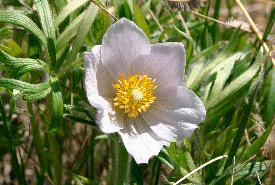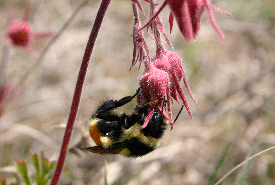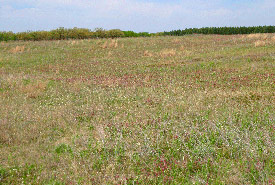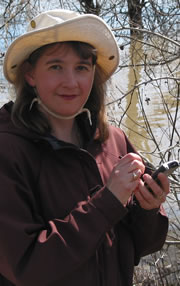Observing the pollinators of the prairie

Prairie crocus finishes flowering in early May (Photo by Diana Robson)
Summer is in full bloom at the Yellow Quill Prairie Preserve, and once again, I’m studying pollinators at this Nature Conservancy of Canada (NCC) property, just south of Canadian Forces Base Shilo in Manitoba. Last year I made the mistake of starting my field surveys too late, missing the blooming of a number of early flowering plants, such as American pasqueflower (more widely known as prairie crocus), prairie-smoke and mouse-ear chickweed. This year, I began surveying in mid-May, which was already almost too late for the crocuses, but just in time for the other plants.

A queen bumblebee visiting a prairie-smoke plant. (Photo by Diana Robson)
It wasn’t the busiest time on the prairies for bees, as populations are not at their peak yet; but it’s a very important time for the queen bees as this is when they start feeding. Queen bees are the only bees that survive winter, and do so by hibernating in the soil. In spring, the hungry queens begin feeding on pollen and nectar from the early blooming wildflowers. Once they have fattened up a bit, they select appropriate nesting sites and lay the eggs that will produce the first worker bees. Some queen bees brood their eggs, keeping them warm until they hatch. These workers typically start showing up in June.
My task this May was to find out what the queens and her workers were feeding on. Bumblebees were most fond of prairie-smoke, with 61 per cent of all visits being to that species, followed by mouse-ear chickweed at 25 per cent. Andrenid bee species, on the other hand, preferred the chickweed, visiting it 95 per cent of the time. The little sweat bees weren’t terribly abundant yet, but those that were out only visited the chickweed. In fact, one day it was so windy that I didn’t see any sweat bees at all.

Streaks of pink and white represent prairie-smoke and chickweed flowers in abundance. (Photo by Diana Robson)
If they had ventured out, they would have been incapable of flying without getting completely blown off course, as the wind speed was almost 50 kilometres per hour.
Interestingly, I also saw domesticated honeybees visiting prairie-smoke and chickweed in equal numbers. These honeybees are kept by one of the nearby farmers and, since there were no crops in flower yet, they were out searching for something to eat. To me, this clearly demonstrates the value of prairie preserves. Wild prairie preserves provide us with benefits such as helping pollinating insects survive and reproduce. They are a safe place for nesting and are a source of honey for us to eat.
Happily, except for the strong wind that one day, the weather was great during my surveys: sunny and warm. Hopefully my luck will hold out and I’ll have clear skies for my next field trip.


